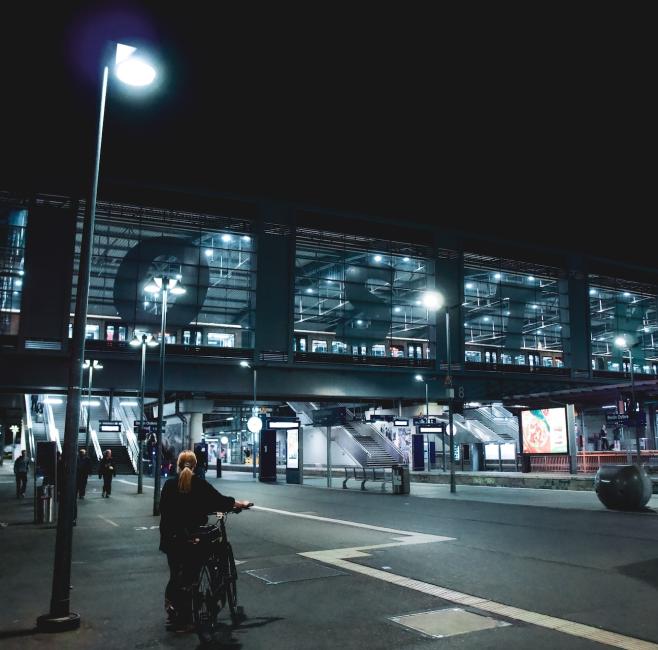After half a century in which the automobile undisputedly reigned supreme, active, light and collective mobility solutions are reshuffling the cards. As such, mono-functional infrastructure such as the railway station, the underground station or even the good old car park are set to evolve. Whatever their name, nodes, poles and other transit hubs are reinventing themselves as interfaces, making it easier to transfer from one mobility to another and increasing the number of services on offer.
Leonard delved a little deeper into the topic when it interviewed Yo Kaminagai, head of design within the Parisian Autonomous Transport Administration’s project management department, taking a look at the major issues linked to mobility hubs, from their design to how they’re integrated into public space.
How would you define a “mobility hub”?
There is a fairly basic definition. UITP (the International Association of Public Transport) assigns two main functions to mobility hubs. The first concerns transfer between modes: a hub allows you to go from walking to taking the bus, from the bus to the underground, from the metro to a plane, etc. The second function is that of access to mobility and a city’s different facilities. From the moment these two functions of transfer and access are fulfilled, other urban uses – such as retail – can be added, because these places become prominent poles in the urban fabric.
There is often recurring confusion between two main types of products. On the one hand, there’s what we used to call “multimodal interchange hubs” which link heavy-goods transport and transport infrastructural, such as the metro, suburban RER trains or the train, with surface modes, such as buses and individual transport modes. On the other hand, the term can also mean “micro” mobility hubs, which have been popping up all over for the past ten years or so now, more so elsewhere than in France. They combine car sharing, bicycle parking, bike-sharing systems, kick scooters, parcel drop-off and pick-up lockers. The former are “macro-hubs” and the latter “micro-hubs,” which can be contained within the former. Most of the time, the two are designed independently.
Do you have any prime examples of both types?
“Micro” hubs are proving to be very popular in northern and eastern Europe. In Flanders, the Mobipunt project aims to deploy 1,000 micro hubs. Meanwhile, the Hvv Switch stations in Hamburg are combined with a fairly comprehensive mobility app. And in Berlin, Jelbi stations are dotted all about the city. The same system also exists in Dresden and Vienna.
Large interchange stations are well developed and particularly interesting in the Netherlands, where Utrecht Centraal and Rotterdam Centraal serve as models. For a similar example in France, on one end of the scale you’ve got La Défense hub in Paris: it’s compact, offers uninterrupted flows, and is an example of visionary urban planning from the 1960s whose renovations and adaptions have been rather successful. On the lower end of the scale, there’s Place Napoléon in La Roche-sur-Yon, which is less concrete and more people-centric: it’s an old car park that’s been converted into an open esplanade space with bus lines running around the edge. It offers a fine example of when transport and other urban functions combine.
What are the best practices when designing, planning and managing these hubs?
The first is to implement a global planning, so that all types of connections and transfers can be taken into consideration into the architectural design right from the start. This is the case for the metro in Washington, where you’ll find extraordinary structures with perpendicular cross vaults, where you can change lines by simply taking an escalator. There’s a similar notion of integration present in Sao Paulo’ metro too. These two examples are both networks inaugurated in the 1970s. In London, when the Jubilee underground line was extended, the bus station was built in the same building at Canada Water. In Shinjuku, Tokyo, the bus terminal was added on the station’s rooftop. Unfortunately, comprehensive intermodal planning is not always possible. It requires a “supra” entity – like a region, a city or a state – that has a long-term vision and a strong authority over the entire ecosystem of stakeholders.
The second best practice is to implement effective governance for day-to-day management. Most of the time, many stakeholders coexist in hubs, but without collectively cooperating. Travellers are transferred about like parcels. Generally speaking, project governance, which guarantees QCD (quality, cost, delivery) is well implemented. The problems arise after delivery, with operators who do not form a consortium to manage the shared space and who each manage their own property.
What impact do these infrastructures have on roads?
The development of multimodality is reducing the role of the car. For a city’s traditional stakeholders, this means acquiring expertise in pedestrian, bicycle and public transportation engineering, as well as automotive engineering, and mixing these different cultures. We often think of the pavement as incidental compared to the road, whereas it should at least be equal to it. In Haussmannian design, a sort of hierarchy between roads and pavements was established, but this must now be re-examined. In a way, roads in cities is an outdated concept. Streets tomorrow will not necessarily be linear, and so connections can be provoked almost everywhere.
How do you imagine the future of intermodal mobility hubs?
They deserve a call to arms. Those at the highest level of power really need to become conscious about the importance of hubs. The European Union has created a theoretical framework with the TEN-T. It is a network of nine core corridors that cover Europe with 424 urban nodes. These nodes themselves host urban hubs. There is a willing at European level to propose “reparation” with connection points, so that trans-European mobility becomes competitive by land.
Following the realisation of their importance, it’s time to move on to the next step. Most mobility policies have focused on lines or routes, speed, automation or technology. Now, we urgently need to focus on places, because this is where most of the pain points are found. Concentrating on the place itself is not a consolation prize, it’s strategic action. Multimodality is not native, it’s absolutely unnatural, and it must be purposeful.
The 1,001 faces of the mobility hub
Hyper-connected stations: Bus station or train station? There’s no longer need to choose. Most new infrastructures are designed to “natively” integrate all modes of transport. In Nice, the Nice Saint-Augustin multimodal hub (France) will be the first in Europe to integrate numerous solutions, including buses, intercity coaches, active mobility, parking spots for private vehicles, the tram, TER local trains, TGV high-speed trains and an airport shuttle service.
Airport turned mega mobility hub: As “macro” infrastructures par excellence, airports are experiencing a similar shift, impacting mobility on a regional or even national scale. In Poland, the Centralny Port Komunikacyjny (CPK) project embodies this trend. Scheduled for completion in 2028, it’s designed to handle 40 million passengers per year and serve as the central element of a more global project, which includes, for example, the construction of 2,000 kilometres of high-speed train lines.
Car parks reinvented: The ultimate face of the car’s reign, car parks are now opening up to multimodality. In the Netherlands, Q-Park and Shell are joining forces to transform their infrastructures into mobility hubs by integrating charging points and active mobility. In Spain, Madrid’s Municipal Transport Company (EMT) recently launched Canalejas 360, a mobility hub that will transform an entire level of an underground car park into charging areas for electric vehicles, as well as bicycle parking and designated parking bays for shared vehicles. In Paris, the startup DouzePointCinq is investing in vacant, unleased car parks to install parking spaces for two-wheel mobility modes.
Motorways hosting multimodality? Main highways and motorways are also opening up to new mobility solutions and other modes of transport. In Nîmes, the local authorities and VINCI Autoroutes have introduced a new carpooling area to encourage people to travel more eco-friendly. In Briis-sous-Forges, a motorway bus station – the first of its kind in France – is proving to be a victim of its own success! As such, it has led VINCI Autoroute to carry out a pilot project with autonomous and connected shuttle buses, which connect Longvilliers multimodal hub to the Briis-sous-Forges motorway station and Massy-Palaiseau railway station, at a speed of 90 km/h! In Madrid, the highways leading to the capital’s circular metro line feature dedicated lanes reserved for radial buses and coaches which link to formidable underground bus stations, thus enabling them to avoid crossing the last congested intersections of the ring road. What this does is rapidly distributed passengers from these vehicles towards city bus and metro lines: these hubs are called intercambiadores, and they are unique in the world in their ability to connect a highway to public transport.



